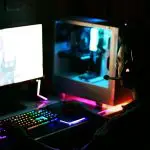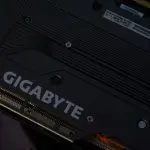
NVIDIA and MediaTek’s partnership will integrate G-SYNC display technologies into a wider range of gaming devices without the need for a proprietary G-SYNC module.
G-SYNC is a technology first introduced in 2013 that offers gamers superior image quality, unmatched motion clarity, ultra-low latency, and highly accurate colors on their display monitors. It usually requires a dedicated module so G-SYNC can synchronize the monitor to the output of the GPU instead of the GPU to the monitor. Since then, many of its iterations have included features such as ULM, Reflex Analyzer, and Pulsar.
The need for a G-SYNC module seems rather restrictive. So, in 2019, Nvidia created a way to support variable refresh rate monitors with FreeSync technology instead of requiring a module. and integration within a range of monitor types, such as G-SYNC Compatible, G-SYNC Ultimate, and Big Format Gaming Displays (BFGDs) segments.
Now, NVIDIA has collaborated with MediaTek to bring all those features to a wider range of monitors with MediaTek’s G-Sync scaler. Aside from eliminating the need for a separate G-SYNC module, the production process will be more streamlined, resulting in more attractive prices.
In addition, the features expected to be included are Variable Refresh Rate, Variable Overdrive, 12b Color Accuracy, Ultra-Low Motion Blur, Low Latency HDR, Reflex Analyzer, Pulse, and more.
NVIDIA promises that monitors with MediaTek G-Sync scalers will perform on par with those using dedicated G-Sync modules. It will just provide gamers with more affordable and diverse options, making high-quality gaming accessible to a broader audience.

This new technology is confirmed to be shipped out on the new monitors, namely the ASUS ROG Swift 360Hz PG27AQNR, Acer Predator XB273U F5, and AOC AGON PRO AG276QSG2. These are expected to be released later this year with a 2560×1440 resolution and a 360Hz refresh rate, along with HDR support.
NVIDIA is set to expand the range of monitors to support this technology, including G-Sync Pulsar, NVIDIA’s latest technology to reduce motion blur and ghosting, which was recently announced at CES 2024.
“We are working with MediaTek to bring G-Sync to their market-leading monitor scalers,” says NVIDIA. “We will bring all the G-Sync technologies, including our most recent—Pulsar—to many more gamers, and we’ll continue to create more G-Sync technologies with the MediaTek scaler solutions.”
NVIDIA confirmed its partnership with MediaTek amid rumors of their collaboration on an Arm-based chip for artificial intelligence (AI) computers, potentially including a dedicated chip for handheld gaming devices. While it remains a rumor, reports suggest plans for an Arm PC chip launch by 2025, with Dell’s CEO hinting at NVIDIA’s possible entry into the AI PC market as early as next year.










